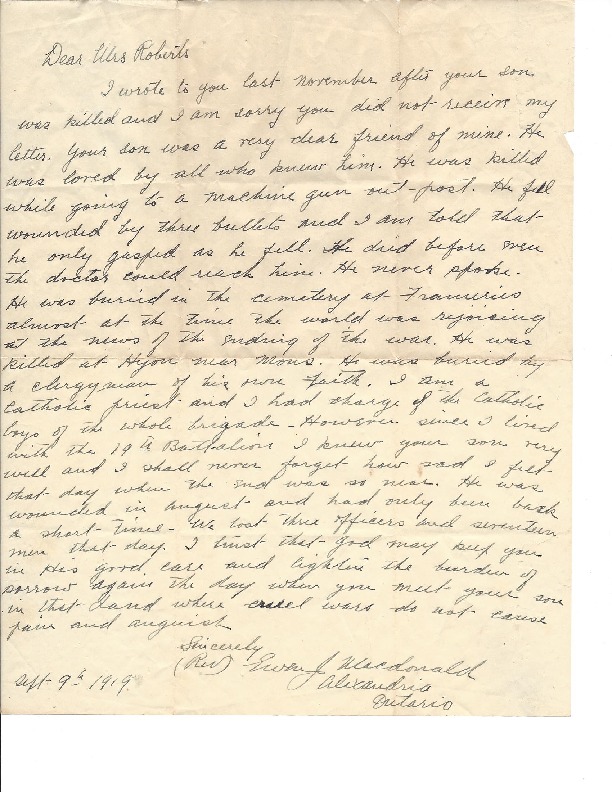Additional Biographies from WWI
Major Russell B. “Punk” Thomson, OC, D Coy, 19th Battalion (1888–1917)
Tonight we remember Russell Thomson, known to his brother officers as “Punk.” He joined the 91st Canadian Highlanders in the years before the First World War. Like many from the 91st, he joined the 19th Battalion, CEF, on the outbreak of war; in his case, it was 12 May 1915 and the officer signing him in was Maj Lionel Millen, later the battalion’s CO for most of the war. Punk Thomson was a Hamilton-born Canadian of a Scottish father. He was a salesman, a Presbyterian, and single. At 5’, 10 ½ “with fair skin, blue eyes, and blonde hair, he was popular with officers and troops alike.
On 9 April 1917, the Canadian Corps, all four divisions, attacked Vimy Ridge. Thomson then commanded D Coy. In the early hours of the morning, he quietly moved up and down the line, offering a pat on the back, a handshake, and some final words of encouragement to his men. When the attack commenced, he was one of the first killed that day. Major D.E. Macintyre, the chief staff officer of the 4th Brigade, came across his body. He wrote:
In No Man’s Land I recognized an officer of the 19th Battalion with whom I had enjoyed dinner a short time before the battle, and with whom I had played basketball in Canada. He lay in that awkward humpbacked posture I had so often observed in the dead, made more conspicuous by the heavy pack on his back as though the load had been too heavy and he had stumbled and fallen face down, his knees buckled under him, his hands spread before him. A gallant officer who died leading his men.
Thomson had been a popular officer and his death came as a sad blow for his friends in the battalion. “Poor Punk Thomson,” wrote Lieutenant-Colonel Millen, “I am glad he never knew what struck him. I went out myself with some other officers and found his body, and we were able to give him a proper burial in a regular cemetery.” At Vimy, the 19th had: 27 KIA, 154 wounded, and 27 missing. Thomson was among the dead; he is buried in the Ecoivres Military Cemetery, 1.5 km. from St Eloi. Thomson left his battalion, his company, his parents, his friends, and his siblings to grieve. We shall remember him.
Read during the 2013 Regimental Remembrance Day ceremony at the Argyll Commemorative Pavilion, Hamilton, Ont.
Maurice Cameron Roberts
(19 August 1897–10 November 1918)
Maurice Cameron Roberts was born on 19 August 1897 in Hamilton; he had one sister and two brothers. He graduated from high school in 1911, and two years later he was admitted to the Law Society of Upper Canada as a law student. He articled in Hamilton.
Prior to enlisting with the CEF, Roberts had been a cadet and served in the militia with the 91st Canadian Highlanders and the 12th York Rangers. He enlisted in January 1916 as a lieutenant with the 120th (City of Hamilton) Battalion. It went overseas in August 1916 and, like so many other battalions, was broken up for reinforcements.
Roberts went to the 19th (Central Ontario) Battalion on 28 Oct. 1916 and joined it in the field a few days later. He was made an acting captain in November 1917 and promoted to captain the following month.
Roberts was wounded in August 1918 and invalided to England, but he returned to the front at the end of October. He was killed in action shortly thereafter, on 10 Nov. 1918, while in command of A Company during the last battle of WWI. He was 21 years old.
The 19th encountered heavy resistance as it advanced to the village of Hyon on the way to Mons. The advance was halted by machine-gun fire, and Roberts was hit in the legs proceeding across a strip of ground to obtain necessary information from the company holding the flank; he died soon afterwards. By 0200 on 11 Nov. 1918, the 19th Battalion had pushed through Hyon. At 0710, only hours after Roberts had died, a wire was received at the brigade headquarters that read:
Hostilities will cease at 11.00 hours November 11th. Troops will stand fast on the line reached at that time, which will be reported to Divisional H.Q.s immediately. Defensive precautions will be maintained. There will be no intercourse with the enemy of any description. Further instructions will follow.
The 19th Battalion lost four officers, including Roberts, and 17 men that day in the closing hours of the war. On 13 Nov. 2013 at 1500, a public funeral was held for all the officers and men that had fallen in closing hours of the war. The 19th Battalion’s war diary states that floral tributes were sent by the civilian population to decorate the graves. Roberts is buried at the Frameries Communal Cemetery (II.A.2.) in Belgium. A tablet commemorating these fallen Canadians has since been placed in Hyon Parish Church.
Cameron Roberts was awarded the Military Cross on 14 May 1918. The Military Cross (MC) was created in December 1914 to recognize “an act or acts of exemplary gallantry during active operations against the enemy on land.” The citation for Roberts’ MC reads:
For conspicuous gallantry and devotion to duty. When the unit on his right was driven back, this officer counter-attacked, bombing along 150 yards and establishing a block in the trench. Then after organising a support platoon in case he was driven out, he sent back a report on the situation. Later, with five men, he went on down the trench and gained another 50 yards, bombing out an enemy party. Throughout the day his work was splendid.
Capt Cameron Roberts will not be forgotten!
